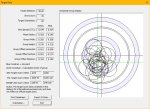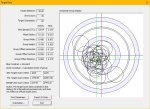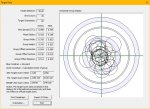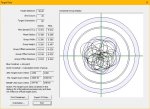After reading Tim K's thread , I thought I would share some very interesting results from some testing that I did a couple of weeks ago . A fellow competitor was having a re-barrel of his match 40x that was finally done that we need to pick up out in the middle of nowhere USA . We then headed north another couple of hours to a private test tunnel owned bye a national level competitor that we had an open ended invitation to come stay and test . Plan was to shake down the new build and put a tune on it , as well as test my rifle with a couple lots of ammunition . [IMG2=JSON]{"data-align":"none","data-size":"full","src":"http:\/\/i768.photobucket.com\/albums\/xx323\/67rschev\/IMG_1498_zpsxb52tvwu.jpg"}[/IMG2]
Well the 40x with brand new Ratchet , went real sideways on us . Tried everything to get it to shoot for a few hours , he would be better off with a 200 dollar 10 / 22 it was that bad . We then got on to testing my Stiller Lonestar . The testing preformed was shot very similar to the KSS Eley Mobile facility . You take a cleaned gun , 10 sighters-foulers-scope adjustment , then 4 targets of exactly 25 individual bulls each ( ARA style and target ) . All shot consecutively with no cleaning in between , and held on the center dot . No adjustments in POA once started , was damn maddening not being able to hold over once started . No fixture for the action like the mobile lab , we were using an Arnold 1 piece roller rest so about as repeatable as possible . Now just as I started , a large storm cell rolled over . During the first two targets the humidity level jumped 50 points due to the downpour and temperature dropped 17 degrees in 20 minutes . Here are the compiled 25 bulls down to 1 screen shot in order target one to target four . [IMG2=JSON]{"data-align":"none","data-size":"full","src":"http:\/\/i768.photobucket.com\/albums\/xx323\/67rschev\/thumbnail_tdsT1_zpsaiiifjmx.jpg"}[/IMG2]
[IMG2=JSON]{"data-align":"none","data-size":"full","src":"http:\/\/i768.photobucket.com\/albums\/xx323\/67rschev\/thumbnail_tdsT2_zpshmmx2vyd.jpg"}[/IMG2]
[IMG2=JSON]{"data-align":"none","data-size":"full","src":"http:\/\/i768.photobucket.com\/albums\/xx323\/67rschev\/thumbnail_tdsT3_zpsy23feyet.jpg"}[/IMG2]
[IMG2=JSON]{"data-align":"none","data-size":"full","src":"http:\/\/i768.photobucket.com\/albums\/xx323\/67rschev\/thumbnail_tdsT4_zpsmjoddbx5.jpg"}[/IMG2]
It was very interesting to watch the first target fall apart on me whet the rain hit , and the second completely scatter with a major shift in ambient conditions . Although while shooting the targets I was more thinking that the ammunition choice may have been wrong , and the rig was shooting poorly . I always knew things such as temp and humidity played a role , but when shooting for score we are always shading / changing POA on the target due to conditional changes and fouling , so they never seemed as drastic . And then once the ambient conditions settled for target 3 and 4 , the gun settled and started to shoot this particular lot of Eley Black Match as it had preformed in the past .
For some more interesting data . Every shot was run over two chronographs and then was plotted on a graph with the POI compared to POA in relationship to speed . Here is the conglomerate of the 4 targets shot 1 to 4 , top to bottom . [IMG2=JSON]{"data-align":"none","data-size":"full","src":"http:\/\/i768.photobucket.com\/albums\/xx323\/67rschev\/thumbnail_Stat%20Summery_zpsjvuikw8x.jpg"}[/IMG2]
You might have to ramp up the magnification to read the graphs , best I could post of the screen shot . Some interesting things I noticed there . We all know how important ES and SD is , especially when we are at the mercy of the ammunition manufactures like we are when shooting rimfire . Its know fact ... blah blah blah ... that faster shots will vertically impact higher than slow . Overall you can see by the lines that this holds relatively true . But look closely , for example target 2 the one went scatter on me . The lowest impacting shoot , was dead nuts in the middle speed wise . Target 3 , the slowest shot was one of the top 5 highest impacting shots . I could go on and on looking at this data about the speed vs vertical point of impact . Also , the best target #4 had the worst SD and second worst ES , the second best target #3had the largest ES and second worst SD . Guess what I'm saying is there are many many more subtle things we deal with when shooting these silly guns that have a profound impact on what we see down range besides speed . From temp to humidity to barrel fouling to ignition condition all plays a role .
YMMV
Well the 40x with brand new Ratchet , went real sideways on us . Tried everything to get it to shoot for a few hours , he would be better off with a 200 dollar 10 / 22 it was that bad . We then got on to testing my Stiller Lonestar . The testing preformed was shot very similar to the KSS Eley Mobile facility . You take a cleaned gun , 10 sighters-foulers-scope adjustment , then 4 targets of exactly 25 individual bulls each ( ARA style and target ) . All shot consecutively with no cleaning in between , and held on the center dot . No adjustments in POA once started , was damn maddening not being able to hold over once started . No fixture for the action like the mobile lab , we were using an Arnold 1 piece roller rest so about as repeatable as possible . Now just as I started , a large storm cell rolled over . During the first two targets the humidity level jumped 50 points due to the downpour and temperature dropped 17 degrees in 20 minutes . Here are the compiled 25 bulls down to 1 screen shot in order target one to target four . [IMG2=JSON]{"data-align":"none","data-size":"full","src":"http:\/\/i768.photobucket.com\/albums\/xx323\/67rschev\/thumbnail_tdsT1_zpsaiiifjmx.jpg"}[/IMG2]
[IMG2=JSON]{"data-align":"none","data-size":"full","src":"http:\/\/i768.photobucket.com\/albums\/xx323\/67rschev\/thumbnail_tdsT2_zpshmmx2vyd.jpg"}[/IMG2]
[IMG2=JSON]{"data-align":"none","data-size":"full","src":"http:\/\/i768.photobucket.com\/albums\/xx323\/67rschev\/thumbnail_tdsT3_zpsy23feyet.jpg"}[/IMG2]
[IMG2=JSON]{"data-align":"none","data-size":"full","src":"http:\/\/i768.photobucket.com\/albums\/xx323\/67rschev\/thumbnail_tdsT4_zpsmjoddbx5.jpg"}[/IMG2]
It was very interesting to watch the first target fall apart on me whet the rain hit , and the second completely scatter with a major shift in ambient conditions . Although while shooting the targets I was more thinking that the ammunition choice may have been wrong , and the rig was shooting poorly . I always knew things such as temp and humidity played a role , but when shooting for score we are always shading / changing POA on the target due to conditional changes and fouling , so they never seemed as drastic . And then once the ambient conditions settled for target 3 and 4 , the gun settled and started to shoot this particular lot of Eley Black Match as it had preformed in the past .
For some more interesting data . Every shot was run over two chronographs and then was plotted on a graph with the POI compared to POA in relationship to speed . Here is the conglomerate of the 4 targets shot 1 to 4 , top to bottom . [IMG2=JSON]{"data-align":"none","data-size":"full","src":"http:\/\/i768.photobucket.com\/albums\/xx323\/67rschev\/thumbnail_Stat%20Summery_zpsjvuikw8x.jpg"}[/IMG2]
You might have to ramp up the magnification to read the graphs , best I could post of the screen shot . Some interesting things I noticed there . We all know how important ES and SD is , especially when we are at the mercy of the ammunition manufactures like we are when shooting rimfire . Its know fact ... blah blah blah ... that faster shots will vertically impact higher than slow . Overall you can see by the lines that this holds relatively true . But look closely , for example target 2 the one went scatter on me . The lowest impacting shoot , was dead nuts in the middle speed wise . Target 3 , the slowest shot was one of the top 5 highest impacting shots . I could go on and on looking at this data about the speed vs vertical point of impact . Also , the best target #4 had the worst SD and second worst ES , the second best target #3had the largest ES and second worst SD . Guess what I'm saying is there are many many more subtle things we deal with when shooting these silly guns that have a profound impact on what we see down range besides speed . From temp to humidity to barrel fouling to ignition condition all plays a role .
YMMV
Last edited:






